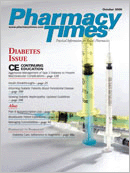Publication
Article
Pharmacy Times
Many Potential Sources for Drug-induced Rhabdomyolysis
Author(s):
The views expressed are those of the author and not those of any government agency.
The first known description of rhabdomyolysis can be found in the Bible (Numbers 11:31-33). It tells of a plague inflicted on the Israelites who ate quail that had fed on hemlock.1 Rhabdomyolysis is a potentially life-threatening condition resulting from skeletal muscle injury and a rapidly rising intracytoplasmic calcium concentration. Excess intracytoplasmic calcium causes muscle destruction and fiber necrosis, leading to excessive potassium, phosphate, myoglobin, creatine kinase, and urate release into the systemic circulation.2 Early complications of rhabdomyolysis include hypokalemia (causing cardiac arrhythmia and possibly cardiac arrest), hypocalcemia, and hepatic dysfunction. Late complications, occurring after 12 to 24 hours, include acute renal failure and disseminated intravascular coagulation (DIC).2-4 Direct muscle injury, excessive physical exertion, muscle ischemia, hypothermia, hyperthermia, infection, toxins, recreational drugs, and pharmaceuticals can cause rhabdomyolysis. Drug-induced rhabdomyolysis is one of the most common forms, ranging from an asymptomatic to a life-threatening illness. The underlying cause will determine the clinical course. Myoglobin destruction causes the cardinal sign of rhabdomyolysis: teacolored urine. Muscle weakness, myalgias, swelling, stiffness, and cramps also may occur.2-4 The most sensitive biochemical indicator, a creatine kinase reading at least 5 times higher than normal, is the accepted diagnostic standard. A ratio of blood urea nitrogen to serum creatinine of 6:1 or less indicates increased creatinine release from skeletal muscle and renal dysfunction.2,5 An increase or decrease in potassium, phosphate, or calcium may occur, depending on the severity, duration, and management of the patient's rhabdomyolysis. Arterial blood gas analysis can detect hypoxia and acidosis; urinalysis can reveal protein, brown casts, and uric acid crystals; an electrocardiogram may show abnormalities; and clotting studies diagnose DIC.2,4 More than 150 recreational drugs, pharmaceuticals, and toxins (Table5-10) may alter myocyte function, resulting in rhabdomyolysis. Calcium metabolism inhibition by the sarcoplasmic reticulum, impaired adenosine triphosphate production causing cell membrane disruption, and carbohydrate metabolism alterations are proposed direct mechanisms. Indirect mechanisms include prolonged immobilization and muscle compression from drug-induced coma, seizures, myoclonus, and trauma (ie, tissue ischemia and crush injury), resulting from drug-induced altered mental status, agitation, and delirium.4
- Eliminate exposure to the toxic agent
- Begin symptomatic treatment immediately in patients with acute rhabdomyolysis
- Use pharmacologic agents to prevent agitation, seizures, and abnormal movements; external cooling to treat hyperthermia; and benzodiazepines to control muscular hyperactivity
- Correct and control hyponatremia, hypernatremia, hyperglycemia, hypocalcemia, and decreased phosphorus
- Restore intravascular volume
Alkalinizing the urine and mannitol may be effective in some patients with acute renal failure. Patients with severe metabolic abnormalities and renal dysfunction may require dialysis.3,5 Final Word When drug-induced rhabdomyolysis is suspected, pharmacists should review all manufacturer-provided information and any available literature to determine the probable cause as well as specific management recommendations. If rhabdomyolysis is recognized early, the prognosis usually is excellent.3 Finally, patient education should focus on preventing and minimizing adverse effects. Dr. Grandinetti is a senior clinical research pharmacist at the National Cancer Institute, Division of Cancer Treatment and Diagnosis/Cancer Therapy Evaluation Program, Pharmaceutical Management Branch, in Rockville, Md. For a list of references, send a stamped, self-addressed envelope to: References Department, Attn. A. Rybovic, Pharmacy Times, Ascend Media Healthcare, 103 College Road East, Princeton, NJ 08540; or send an e-mail request to: [email protected]

Newsletter
Stay informed on drug updates, treatment guidelines, and pharmacy practice trends—subscribe to Pharmacy Times for weekly clinical insights.






